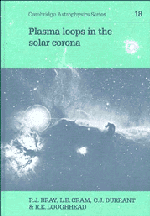Book contents
- Frontmatter
- Contents
- Preface
- Acknowledgements
- Other books by the authors
- List of abbreviations
- 1 Historical introduction
- 2 Cool loops: observed properties
- 3 Hot loops: observed properties
- 4 Flare loops: observed properties
- 5 Structure, dynamics and heating of loops
- 6 The plasma loop model of the coronae of the Sun and stars
- Additional notes
- Name index
- Subject index
1 - Historical introduction
Published online by Cambridge University Press: 22 October 2009
- Frontmatter
- Contents
- Preface
- Acknowledgements
- Other books by the authors
- List of abbreviations
- 1 Historical introduction
- 2 Cool loops: observed properties
- 3 Hot loops: observed properties
- 4 Flare loops: observed properties
- 5 Structure, dynamics and heating of loops
- 6 The plasma loop model of the coronae of the Sun and stars
- Additional notes
- Name index
- Subject index
Summary
Eclipse observations of prominences: Middle Ages to 1868
Historically, visual observations of prominences were the first to reveal the existence of well-defined loop structures arching upwards from the surface of the Sun high into the overlying corona. Regular visual observations of prominences obtained during total eclipses of the Sun date from 1842, but sporadic reports go back to the Middle Ages. Most of the early descriptions of the eclipses refer only to the corona but there are specific references to prominences in medieval Russian chronicles. For example, in the first volume of his well-known book Le Soleil (1875, p. 330) the Italian astronomer Father Angelo Secchi (1818–78) cited the description of a prominence observed at the eclipse of 1239. According to Secchi, this was the most ancient eclipse for which a detailed description of the corona was then extant. Early eclipses were extensively described by the historian R. Grant in his History of Physical Astronomy (1852). Grant concluded, pessimistically but realistically, that ‘Down to the beginning of the eighteenth century, the accounts respecting total eclipses of the sun, contain very few remarks which are of advantage in forming the basis of any physical enquiry’.
By contrast, the arrival of the eighteenth century saw a growth in the spirit of exact enquiry in many branches of science.
- Type
- Chapter
- Information
- Plasma Loops in the Solar Corona , pp. 1 - 26Publisher: Cambridge University PressPrint publication year: 1991



